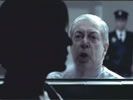Eye For Film >> Movies >> The Nameless (1999) Film Review
You might not jump out of your seat in fright - but I guarantee The Nameless will have you on the edge of it, probably hiding behind a cushion like a little girl, from beginning to end.
Rather than bombard viewers with shocking scares, Jaume Balaguero's multi-award-winning feature debut builds up an overwhelming and oppressive sense of dread with plenty of suspense thrown in. As the characters' fear grows, so does yours - and the film is more chilling than a snowball down the pants.

Based on Brit horror writer Ramsey Campbell's 1981 novel, The Nameless focuses on grieving mother Claudia, whose six-year-old daughter Angela was abducted and brutally murdered.
When her body was found, it was badly mutilated and difficult to identify. So five years later, when Claudia receives a phone call from a girl claiming to be her daughter, she is keen to believe her child is still alive.
The caller claims she is being held by a mysterious cult who indulge in rituals involving rape and torture and begs to be rescued. Claudia (Emma Vilarasau) recruits the detective who originally worked on Angela's disappearance, Massera (Karra Elejalde), and a reporter, Quiroga (Tristan Ulloa) and tracks down her child - but also finds indescribable evil.
There are a few plot weaknesses - many questions go unanswered - but The Nameless gets it right in so many other areas it is easy to forgive.
Albert Carreras and Xavi Giménez's cinematography is stunning and creates pit-of-your-stomach dread from the off. There is very little colour in the film - the world is icy blue and grey aside from the old home movies Claudia pores over. The vibrant clothes they wear as they frolic in the sun in these films only highlights how dull her life is since her child was taken from her.
The greyness makes the creepy, dark sets - especially the abandoned beach house - all the more grim and Balaguero uses the darkness well, proving that what is implied and imagined by a viewer will always be far more terrifying than what you can show them.
The atmosphere is aided by a sombre score played mournfully on the piano - although the film's main theme, played at the closing credits, is a truly terrible piece of goth pop even black-clad nu-metal kids with more eyeliner than sense would pour scorn on.
The opening scene showing what is supposed to be little Angela's mutilated body is also impressively gruesome - a truly unsettling and grotesque make-up job by the special effects team. It will more than quench the thirst of viewers looking for gore, as there isn't much later on.
As I said, the plot leaves you unsatisfied at times and there is disappointing character stereotyping - the distraught mum, the cynical cop, the inquisitive reporter. We even get a evil genius - the sect's founder Santini (Carlos Lasarte) - who is incarcerated in a mental hospital and interviewed in a scene remniscient of Silence of the Lambs. But the cast all put in decent performances, with Vilarasau in particular shining as the tormented Claudia.
Towards the end our three leads also seem to lose all sense and enter a creepy house we know the deadly sect are hiding in, like dumb blondes in the worst slasher movies. It's too predictable and disappointing but thankfully the end of the movie means once again you can forgive and forget this failing.
You will NOT expect how things pan out, with a glorious plot twist that would have M. Night Shyamalan wetting his knickers. Balaguero sets out to define evil - and he manages it in truly graphic yet glorious style.
Reviewed on: 07 Sep 2006


















